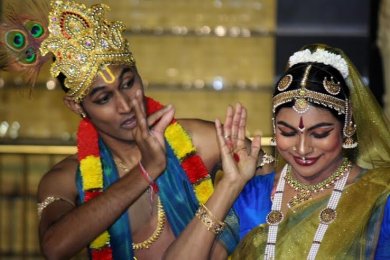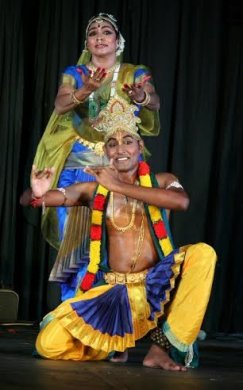
|   |

|   |
Sri Krishna Leela in South Africa - Suria D Govender June 13, 2016 Sri Krishna Leela by Verushka Pather and Natya Ananda Fine Arts Academy was performed at the Shree Veeraboga Emperumal Temple, Tongaat, on 7 May 2016.  This production represents the culmination of years of dance training, art education and research by the producer, director and choreographer of what one may loosely term a dance drama. Apart from her long and arduous Bharatanatyam training and her international performance experience, Verushka Pather found herself being drawn to read and study the Bhagavat Gita a few years ago. After being motivated by devotees of the International Society for Krishna Consciousness (ISKCON) she wrote the script for her interpretation of Sri Krishna Leela which formed the basis for the fund raising performance we saw in Tongaat. In her introduction, Verushka Pather expressed the hope that this offering would provide some respite in this dark age of Kali Yuga, an era in which human beings display aspects that are as far away from god, goodness and morality as is imaginable. The evening comprised a number of scenes which depicted the pastimes of Sri Krishna which were interspersed with narration and poetry which clarified the message and/or specific aspects of Sri Krishna’s identity and make-up through the eyes of his devotee, Poornamasi. These were set on a simply clad stage offering different useful levels and areas and a painting as a backdrop. I felt the dimensions of the painting of Krishna and the Gopikas were too small to provide an adequate backdrop to the drama that unfolded. However the quality of the dance, drama and characterization foregrounded this particular production although it was being presented for the twenty seventh time with excellent sound and lighting expertise. One appreciated the two aspects of Sri Krishna when Rishalan Govender’s excellent characterization made the audience empathize with the mischievous young cowherd who was so enamoured with the Gopikas and who happened to be the Lord of the Universe. The narration by the male voice which accompanied these scenes was well paced and modulated and the messages of strength, valour and spiritual evolution were believable. Unfortunately the narration delivered by the female voice tended to be too mellifluous in tone so that it undercut the seriousness of the message of the scenes it preceded. Different tonal changes tended to make it sound like a children’s story at some points. However the truly superbly chosen backing tracks (flute, voice etc) behind the speaking voices were really quite exquisite to listen to. The opening dance with some eleven dancers provided a well-choreographed appropriate welcome to Vrindavan with a book being carried in representing the 5000 year old leelas which focuses on the true essence of Krishna through the eyes of his true devotee Poornamasi. The Krishna character danced behind beautiful transparent twinkling gauze which whetted the audience’s appetite to witness his unveiling as mischievous boy-god, loving cowherd and finally Lord of the Universe. We were not disappointed when the handsome dancer finally appeared performing nritta (pure dance) and natya (interpretative dance) with equal aplomb. Clear interpretation of excellent choreography to uplifting pieces of classical music began this production and consistently appeared right up to the very last thillana which retained the character of Krishna, the Gopikas and the special relationship between the two. The next piece around Yamuna Devi (Holy River) allowed the use of the stage levels and excellent lighting rig to create a performance of a classical Bharatanatyam repertoire replete with restrained style and perfect discipline.  Apart from the guru, quite outstanding was a consummate Poornamasi played by Premeshni Govender, a senior disciple of Sujatha Veeramani Kannan. She was comfortable in her role and commanded the stage with an enormous presence. It is laudable that the director invited a guest artist to join students from her own school. Such initiatives should be encouraged as the level of Bharatanatyam and indeed any dance form, is elevated when professionals interact closely with each other in productions such as these. Another excellent performance and mature characterization for such a young dancer was that of Yashoda, mother of Krishna, danced by Kriyakshia Govender. A strong duet which made for much enjoyment was executed in the scene depicting Krishna and his mother. The rest of the corps de ballet provided a strong chorus, some less experienced than others, but all highly committed and well trained. When an artist of Verushka Pather’s stature dances alongside her students it could make for jarring comparisons. However, her superior consciousness when it comes to choreography and direction and her ability to throw herself into any role allowed the audience to enjoy the complete picture although they may have been drawn to her infectious joy of the dance from time to time. Her individual slow sustained performances and tremendous scope for natyam (acting and dance) kept one wrapped in the message of pure pain for example when Krishna was banished. Verushka drew one through movement in stillness into the excruciating pain alternating with the sweetness of true love. Then in a tour de force, the suffering of Draupadi is portrayed in the disrobing scene until she is saved by Krishna. To the director’s credit scenes of great angst were followed by quick lighter folk dance pieces with a hint of a change of costume and this provided relief for the audience who had been subsumed by the pathos portrayed especially by the guru. However, I did feel the omission of some scenes which may have included a high point in the drama. I believe this was a truncated version of the production that had travelled abroad and was specially designed for this fundraising event, the running time being approximately an hour and twenty minutes. An announcement clarifying this would have assisted in this regard. The question that must be answered in producing a dance drama steeped in religious fervour is: when is a presentation simply an act of supplication and an offering to godhead and when can it be accepted as an excellent piece of performance art transcending any religion? In the first case it would be a self-serving enterprise while in the second it would serve to move and educate a larger audience. In this particular case the quality of choreography, artistic direction and generally the production achieved the latter aim. The only grouse I have is that it ended quite suddenly and definitely too soon. Dr. Suria D Govender is a Speech and Drama Professor at University of KwaZulu Natal, an intercultural dance practitioner, an artistic director of Surialanga Dance Company and Dancelink, and an Executive member of Sankofa African Renaissance Development Institute. |